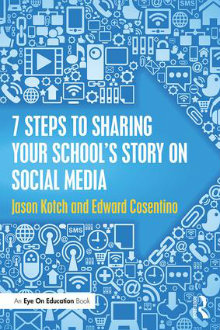Sharing Your School’s Story on Social Media
7 Steps To Sharing Your School’s Story On Social Media
By Jason Kotch and Edward Cosentino
(Routledge/Eye On Education, 2018 – Learn more)

In today’s technological age, it is frustrating to go to a school website and see that it has not been updated for months or even find an old address for a school that moved. The two authors, who are school principals, want school leaders to formulate a social media plan and move beyond the traditional newsletter or static website.

Which Social Media Platforms to Choose
Kotch and Cosentino begin by discussing how to choose social media platforms. Did you know Facebook is most popular with elementary school parents/guardians? Twitter is the most convenient for connecting with other schools. Did you realize Instagram and Facebook can be linked?
Knowing the preferences and platforms of your students and parents will help you set your purpose and set up tools. Step 1 is “Connecting Your Vision and Mission to a Social Media Purpose.” Step 2 explains how to create a unique Twitter hashtag and how to have fun involving your school in creating it.
Step 3 focuses on building a following through traditional methods such as formative assessment. The authors tell exactly how to add a Twitter feed to a homepage and a FB “like” button to your webpage and more. They recommend a consistent e-mail template with a frequent visible profile. Don’t forget face-to-face communication such as open houses, Back-to-School Night, and parent/teacher conferences. Practical tips like postcards and a photo booth can tie these events to your social media.
Step 3 involves making parents comfortable with social media, as well. Learn how you can help them earn “Twitter Wings.” Parent training should include online safety. And don’t forget to have some fun creating school spirit with T-shirts and giveaways.
Policies and Privacy
Step 4, “Making It Happen,” cautions readers to know district policies for social media use. There’s a discussion of student privacy (don’t include students’ names in posts), school vs. personal accounts, setting up a Twitter account, linking across platforms, and a starter guide to some apps and websites.
Step 5, “Will Anyone Follow Me?” discusses types of posts: Informational, Celebratory, and Engaging. Learn ways to increase the likelihood of posts being seen, such as alerts and notifications, and gain a better understanding of privacy settings. Consider ways to moderate comments, monitor followers, and use advance previews.
“How does one know if everything’s working?” is Step 6. Included is how to use the powerful tool Twitter Analytics, conversation tracking on Twitter, building a following, and keeping the momentum going. Facebook Insights is a similar analytic tool to measure your impact.
Ideas from Connected Educators
Step 7 is “What’s Next?” This chapter offers a list of ideas from “connected educators.” Discussed are drones, “GoPro,” “Swivl,” Spark.Adobe.com, blogs and sites for blogging, and more. Use apps to create digital student profiles.
This practical book (also useful to community organizations and clubs) will help leaders keep up with technology and learn to be innovative themselves. It concludes with an invitation for the reader to share their school story and to connect with the authors so they can learn from you.
This is a handy resource that school leaders can return to again and again as they strive to lead a better school for their students.
Mary Langer Thompson is a retired school principal and former English teacher. She received her Ed.D. from University of California, Los Angeles, and lives in southern California in the high desert with her husband Dave. She is currently Director of the Dorothy C. Blakely Memoir Project in which writers go into high schools to help students write memoirs of senior citizens or “Memoir Stars.” Her second children’s book, The Gull Who Thought He Was Dull, will soon be released by Another Think Coming Press.






























